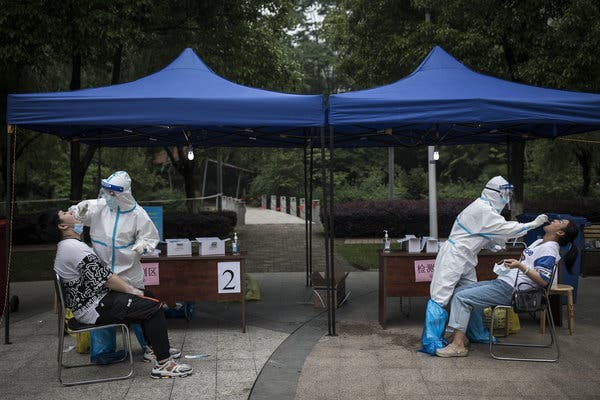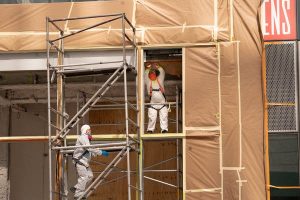Here’s what you need to know:
- W.H.O. gathers to push for global coordination amid a deepening rift between the U.S. and China.
- The economic slump may last until the ‘end of next year,’ the Fed chief warns.
- Governors balance the risks as states try to chart a course to recovery.
- ‘Post-apocalyptic’: What it’s like to drive in New York City.
- Auto production, on hold for nearly two months, is returning.
- How to help your children cope.
- Updates from Times correspondents around the globe.
W.H.O. gathers to push for global coordination amid a deepening rift between the U.S. and China.
The World Health Organization will hold its first global assembly since the outbreak of the pandemic on Monday, an extraordinary virtual meeting of government leaders and health experts from around the world to try to coordinate an effective international response to a crisis that is far from over.
Even as nearly every state across the United States eased restrictions on movement and European nations pushed to restart stalled economies, the virus was still spreading rapidly in other parts of the world, including in Brazil, which has seen explosive growth in new cases in recent days.
Dr. Tedros Adhanom Ghebreyesus, the director general of the W.H.O., said the gathering was perhaps the most important for the world body since it was founded in 1948.
But there is a risk that the gathering serves to underscore division rather than promote unity as the United States and other countries will call for the W.H.O. to investigate China’s response to the coronavirus outbreak.
President Trump and some other world leaders have accused the Chinese authorities of allowing the virus to spread worldwide by suppressing or withholding vital information about it after it emerged in Wuhan, China, in December. In recent weeks, European and Australian officials have joined Mr. Trump in calling for an investigation into China’s handling of the virus and its origins there.
Mr. Trump’s own response to the pandemic has been criticized as slow and ineffective, as he has abdicated responsibility to the nation’s governors and clashed with his scientific advisers. The United States has by far the world’s worst known outbreak, accounting for more than 1.4 million cases of the global total of about 4.6 million, and nearly 90,000 of the global total of more than 314,000 deaths.
Mr. Trump has sought to deflect some of the criticism aimed at him by stirring anger at China and the W.H.O. Last month, after repeatedly claiming that the organization had been too quick to believe the information about the virus coming from China, he ordered his administration to halt funding for the organization — a loss of hundreds of millions of dollars, although his administration has raised the possibility of partly restoring it.
The economic slump may last until the ‘end of next year,’ the Fed chief warns.
Jerome H. Powell, the chairman of the Federal Reserve, said that while he expected the U.S. economy to recover from the sharp and painful downturn brought about by the coronavirus, that process would take time — potentially until the end of 2021.
“This economy will recover; it may take a while,” Mr. Powell said in an interview on the CBS program “60 Minutes.” “It may take a period of time, it could stretch through the end of next year, we don’t really know.”
Asked whether the economy could recover without an effective vaccine, Mr. Powell suggested that it could make a start, but not get all the way there.
“Assuming that there’s not a second wave of the coronavirus, I think you’ll see the economy recover steadily through the second half of this year,” he said. “For the economy to fully recover, people will have to be fully confident, and that may have to await the arrival of a vaccine.”
The interview with Mr. Powell, which CBS said was recorded on May 13, follows a blunt speech he gave the same day, warning that the economy may need more financial support to prevent permanent job losses and waves of bankruptcies.
Asian markets rose broadly, if moderately, on Monday on continuing hopes that the global economy would gradually emerge from the coronavirus outbreak.
Major markets were up less than 1 percent. Oil prices also rose on futures markets, while prices of the longer-term U.S. Treasury bonds fell, both signs of investor optimism. Futures markets were predicting that Wall Street would open about 1 percent higher.
Investors were looking for silver linings as the world grapples with lockdowns and other restrictions.
Governors balance the risks as states try to chart a course to recovery.
“This is really the most crucial time,” Gov. Mike DeWine of Ohio, a Republican, said Sunday on CNN. “And the most dangerous time.”
Mr. DeWine’s assessment was echoed by state leaders across the United States as pressure builds to revive commerce and chart a path for states to stagger back toward a semblance of normalcy.
The push to reopen has been fueled by swelling frustration, as unemployment soars and businesses declare bankruptcy or announce they cannot survive the shutdowns. Some businesses have even reopened in defiance of state orders.
To prevent that, some states are taking extra measures. In Illinois, owners of restaurants, bars and other establishments that open too soon can now be charged with a Class A misdemeanor under a measure enacted by Gov. J.B. Pritzker, a Democrat. The punishment could be up to a year in jail and up to a $2,500 fine. The rule also applies to businesses such as barbershops and gyms, according to Mr. Pritzker’s office.
The virus response has been defined by a balance between curbing the spread and minimizing economic harm. In much of the country, the pendulum has now swung toward the economy.
The shift has come as the national figures for reported new cases of the virus have declined in recent weeks, and as more states have allowed a wider array of businesses to resume. More than two-thirds of states have relaxed restrictions significantly. California, New York and Washington are among those partially reopening on a regional basis. Illinois, Michigan and New Jersey remain fully shut down.
But governors in states where some rules have been eases are still concerned about a resurgence of the virus.
Gov. Gavin Newsom of California, a Democrat, said on CNN that he understood “the stress and anxiety that people have,” citing upended dreams and depleted savings.
“The question is,” he added, “how do you toggle back and make meaningful modifications to the stay-at-home order?”
In New York, state and city officials are calling on many more residents to get tested to help the state reopen.
To underscore this point, Gov. Andrew M. Cuomo on Sunday was tested during his live news briefing. While New York is now doing an average of 40,000 tests per day, Mr. Cuomo said, it has the capacity to perform thousands more. The governor also announced a new website that would help New Yorkers identify a testing site near where they live.
Separately, President Trump continued to express his eagerness to see a resumption of some activities. In telephone comments during a golf broadcast on Sunday, he said he missed sports and wanted “big, big stadiums loaded with people.”
‘Post-apocalyptic’: What it’s like to drive in New York City.

A late morning drive down Fifth Avenue, starting at the Metropolitan Museum of Art, where the lanes are normally choked with inching traffic, now passes by almost impossibly quickly.
The notorious F.D.R. Drive along the East River, prone to random standstills throughout its long stretch, now feels more like a Grand Theft Auto game.
In Brooklyn, turn a corner and see a line of people standing six feet apart and still as stone, masked, awaiting permission to enter Whole Foods.
The virus has transformed the experience of operating a motor vehicle in New York City.
With no office to go to or friends to visit, and facing stern orders to stay home, a vast majority of drivers have left their vehicles idle, creating something altogether new: open road, miles and miles of it.
It cannot last, of course; drivers are already seeing an increase in traffic from a month ago, with much more to follow as people venture out of quarantine, wary of public transportation.
But for now, an emptiness remains. No gridlock, no rush hour. Just numbers rolling over on the odometer, the spring afternoon flitting past the window, the smartphone map showing very little yellow or red.
It’s a very pleasant surprise, until you remember what brought it about, at what cost.
“Post-apocalyptic,” one van driver said of the experience. “You’re flying down 278 and there’s no one there and it’s four o’clock in the afternoon.”
Auto production, on hold for nearly two months, is returning.
After sheltering at home for nearly two months, tens of thousands of U.S. autoworkers have started streaming back into car and truck plants across the South and Midwest, a critical step toward bringing the nation’s largest manufacturing industry back to life.
A return will be gradual but is nevertheless expected to give the economy a much-needed jolt. It will also be critical to the automakers, their dealers and their suppliers, which have lost billions of dollars in sales in recent weeks and have taken on debt to ride out the pandemic.
“The auto industry is America’s economic engine,” Jim Farley, Ford Motor’s chief operating officer, said in a recent conference call on the company’s reopening plans. “Restarting the entire auto ecosystem is how we restart the economy.”
Ford, General Motors, and Fiat Chrysler plan to restart production on Monday, after Toyota, Honda and Tesla began reopening plants last week. Hyundai restarted a plant in Alabama on May 4.
Production will not bounce back quickly. The revival will unfold as dozens of auto plants and hundreds of factories owned by parts suppliers gear up and start making and shipping products.
It will also depend on how quickly stay-at-home orders are loosened in the United States, Canada and Mexico, because the industry’s supply chains are closely intertwined across North America.
How to help your children cope.
Parents can help children use the stress of coronavirus shutdowns as an opportunity for growth, experts say.
Updates from Times correspondents around the globe.
Japan’s economy becomes the largest to officially enter a recession. A Canadian military jet crashes during a flyover for coronavirus workers.
Reporting was contributed by Jeanna Smialek, Neal E. Boudette, Kaly Soto, Marc Santora, Melina Delkic, Abby Goodnough, Adam Liptak, David McCabe, Sharon Otterman, Rick Rojas, Neil Vigdor and Michael Wilson.





















